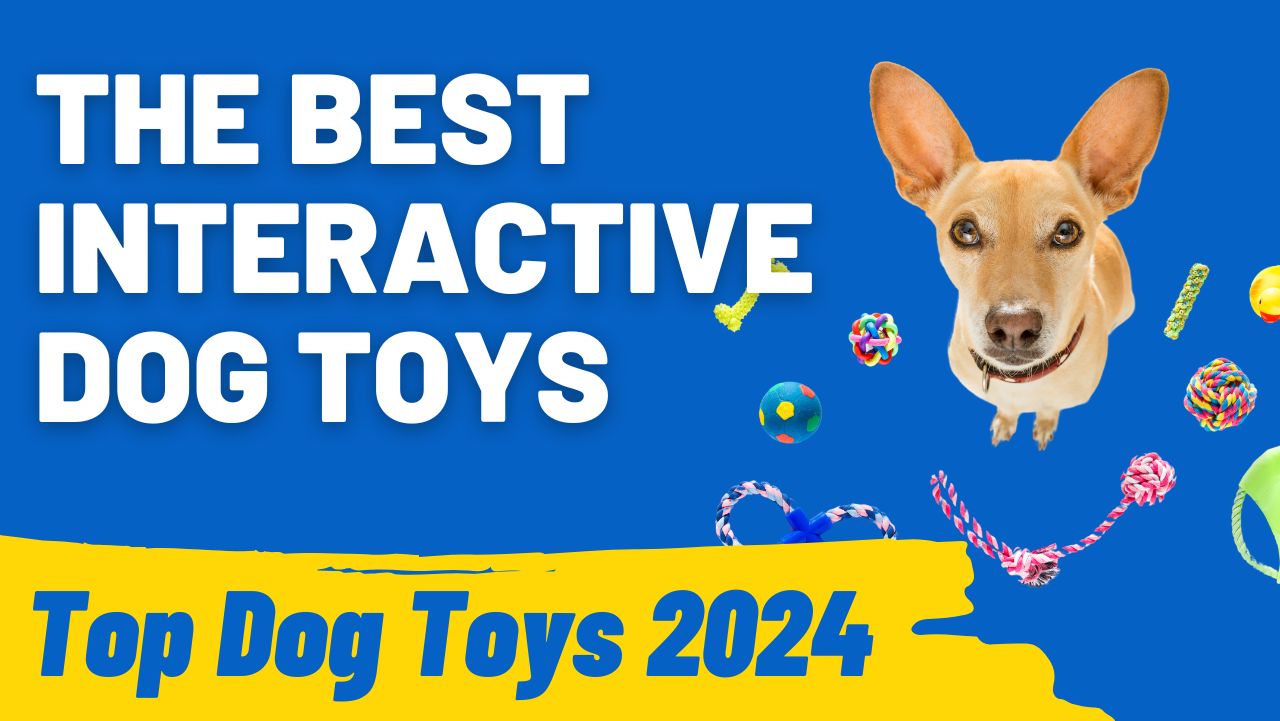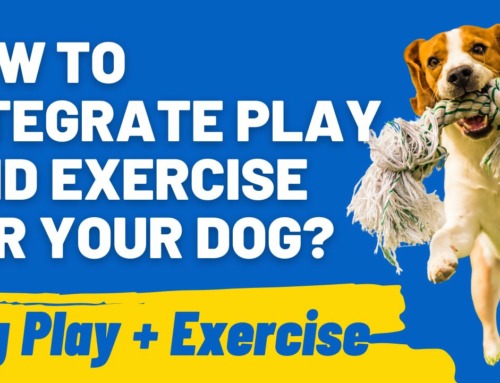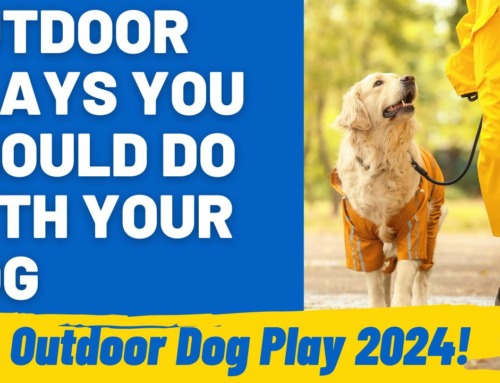Interactive dog play is an essential aspect of a dog’s physical and mental well-being, offering a range of benefits that go beyond mere entertainment.
Finding the right toys to engage your furry friend in meaningful and stimulating activities can enhance their overall quality of life.
This comprehensive guide explores not just the functions of interactive dog play, but also the different types available, factors to consider when choosing them, top picks in various categories, and effective ways to use them.
Why Interactive Dog Toys Matter
Interactive dog toys play a pivotal role in a dog’s life. Not only do they provide entertainment, but they also serve essential functions for a dog’s mental and physical well-being.

These toys are specifically designed to engage a dog’s natural instincts and cognitive skills, offering a more fulfilling play experience than traditional toys.
Mental Stimulation for Dogs
Mental stimulation is as crucial for dogs as physical exercise. Without proper mental engagement, dogs can develop signs of stress, anxiety, and boredom, which can manifest in various undesirable behaviors.
Interactive dog activity toys, especially mental stimulation toys, are designed to challenge a dog’s problem-solving skills and cognitive abilities. They often require dogs to figure out how to obtain a reward, such as a treat or a squeak, which keeps their brains active and engaged.
This kind of mental exercise can help improve a dog’s overall cognitive abilities, keeping their minds sharp and alert.
It also provides an outlet for their natural instincts, such as hunting, foraging, and problem-solving, which are essential for a healthy mental state.
Benefits of Engaging Play
Engaging play is vital for a dog’s overall health and happiness. Interactive dog toys provide more than just physical exercise; they offer a combination of physical and mental engagement that traditional toys cannot match.
These toys often require physical interaction, such as pushing, pulling, or running, which helps in maintaining physical fitness and agility.
Additionally, the mental aspect of figuring out the toy’s mechanism or solving puzzles keeps the dog’s mind engaged. This dual benefit helps in reducing the risk of obesity, improving coordination and motor skills, and keeping the mind sharp.
Engaging play also strengthens the bond between the dog and its owner, as many interactive toys are designed for joint playtime, fostering a deeper connection and understanding.
Preventing Boredom
One of the most significant benefits of interactive dog toys is their ability to prevent boredom.

Dogs, especially those left alone for long periods, can become bored and restless, which often leads to destructive behaviors such as chewing, digging, or excessive barking.
Interactive toys keep dogs occupied and mentally stimulated, reducing the likelihood of such behaviors.
By offering a variety of challenges and stimuli, these toys keep the dog’s mind actively engaged, satisfying their natural instincts and curiosity.
This not only prevents boredom but also promotes a happier, more well-behaved dog, as they are less likely to seek out inappropriate outlets for their energy and intelligence.
Types of Interactive Dog Toys
Interactive dog toys come in various forms, each designed to fulfill different aspects of a dog’s play and cognitive needs. From puzzle toys to treat dispensers, each type offers unique benefits and challenges for your canine companion.
We’ll explore the different types of interactive dog toys and how they can contribute to your dog’s health and happiness.
Dog Puzzle Toys
Dog puzzle toys are designed to challenge a dog’s problem-solving skills. These toys often involve hidden compartments, sliding doors, or movable parts that dogs must manipulate to reveal treats or toys.
The complexity of these puzzles can range from simple to advanced, catering to all levels of intellectual ability. Puzzle toys stimulate a dog’s brain, encouraging them to think critically and solve problems.
This mental exercise can help prevent cognitive decline, especially in older dogs, and keep them mentally sharp and engaged. Additionally, the sense of accomplishment dogs get from solving these puzzles can boost their confidence and overall well-being.
Treat-Dispensing Toys
Treat-dispensing toys are a popular category of interactive and fun dog toys that combine mental stimulation with the reward of a treat. These toys typically require the dog to roll, shake, or manipulate them in a specific way to release treats.
This not only keeps the dog mentally engaged but also encourages physical activity as they try to figure out how to get their reward.
Treat-dispensing toys are excellent for slowing down fast eaters, making mealtime more of a challenge and less of a gulp-down affair. They also provide a fun way to reward dogs for their problem-solving efforts, reinforcing positive behavior and keeping them motivated.
Chew Toys
Chew toys, while often associated with teething puppies, play a significant role in an adult dog’s life as well.
Durable chew toys provide dogs with a safe outlet for their natural chewing instincts, which can be both mentally and physically satisfying. These toys also contribute to dental health by helping to clean teeth, massage gums, and reduce plaque and tartar buildup.
Chew toys that are designed with interactive elements, such as hidden compartments for treats or varying textures, can enhance the engagement level, keeping dogs interested for longer periods and providing prolonged mental stimulation.
Canine Brain Games
Canine brain games take interactive play to the next level by specifically targeting a dog’s cognitive abilities.

These games can include activities like hide-and-seek with toys or treats, interactive electronic games that respond to a dog’s actions, and training games that teach new tricks or obedience skills.
Moreover, these games not only provide entertainment but also enhance a dog’s mental agility and responsiveness. They encourage dogs to use their senses, improve their memory, and develop their decision-making skills.
Canine brain games are an excellent way to keep dogs mentally stimulated, especially on days when physical exercise might be limited.
Toy Variety
Having a variety of toys is crucial for keeping dogs engaged and interested. Just like humans, dogs can become bored with the same toys and activities.
Rotating different types of toys and introducing new ones periodically can keep playtime fresh and exciting.
A mix of puzzle toys, chew toys, treat-dispensing toys, and brain games can cater to all aspects of a dog’s play needs, ensuring that they remain mentally stimulated and physically active.
This variety also helps in identifying which types of toys your dog prefers and responds to best, allowing for a more personalized approach to their play and development.
Factors to Consider
When selecting the right interactive dog toys, there are several factors to consider to ensure the safety, enjoyment, and well-being of your canine companion.
Size and Durability
Choose toys that match your dog’s size and chewing strength. Small dogs need smaller, manageable toys, while larger breeds require durable dog toys. Ensure the toy’s size is appropriate to avoid choking hazards and frustration during play.
Safety and Materials
When it comes to interactive dog toys, safety should always be the top priority. Opt for toys made from non-toxic materials and avoid those with small, detachable parts that could pose a choking risk.
It’s essential to check for any harmful chemicals or dyes in the toys and choose products specifically designed for dogs. Some materials, like certain plastics or rubbers, may be harmful if ingested, so selecting toys made from safe, dog-friendly materials is vital.
Additionally, consider the construction of the toy to ensure it’s sturdy enough to withstand regular use without breaking apart.
Age and Activity Level
Consider your dog’s age and energy level. Puppies might need softer toys, adults a variety of challenging options, and seniors easier, less strenuous toys. Tailor toy choices to your dog’s individual needs and preferences.
Maintenance and Cleaning
Regular cleaning and maintenance are crucial. Follow the manufacturer’s cleaning instructions and regularly inspect toys for damage. Proper care extends the life of toys and ensures ongoing safety and enjoyment for your dog.
Top Picks for Interactive Dog Toys
Choosing the right interactive dog toys can greatly enhance your pet’s playtime and overall well-being. Here, we’ve compiled a list of top picks across various categories, from puzzle toys to canine brain games!
Puzzle Toy Recommendations
- HoundGames Dog Puzzle Toys: These adaptable puzzle treat dispenser blocks have five difficulty levels, perfect for brain-boosting play and suitable for dogs of all sizes and breeds.
- Outward Hound Nina Ottosson Dog Brick: Offers multiple compartments and sliding covers to challenge your dog’s problem-solving skills.
- Trixie Activity Flip Board: Designed for intermediate canine players, featuring various compartments for concealing treats.
Treat-Dispensing Toy Recommendations
- HoundGames Dog Puzzle Toys: As your dog solves the puzzle, treats spill out, providing rewarding and engaging play. Ideal for smart pups seeking a challenge.
- Kong Wobbler: A sturdy, wobble-based toy that dispenses treats as your dog plays, encouraging active engagement.
- PetSafe Busy Buddy Tug-A-Jug: Combines a chew toy, treat dispenser, and tug toy, promoting extended play.
Chew Toy Recommendations
- HoundGames Puppy Toy Mat with Teething Chew Toys: This all-in-one product features chew and rope toys, a nose squeaker, and a high-quality foam mat, perfect for soothing gums and reducing anxiety in playful puppies.
- Nylabone Dura Chew: Designed for powerful chewers, helps clean teeth and control plaque and tartar.
- Benebone Real Flavor Wishbone Chew Toy: Made with real flavors, its unique shape allows easy chewing and a better grip.
Canine Brain Game Recommendations
- Outward Hound Hide-A-Squirrel Puzzle Toy: Encourages natural hunting instincts with squirrels to find and retrieve. This is perfect if you want more intelligent play ideas.
- Trixie Mad Scientist Turn Around Interactive Game: Stimulates your dog’s intellect by rewarding problem-solving with treats.
How to Use Interactive Toys Effectively
Interactive toys can significantly enhance your dog’s playtime, contributing to their physical and mental health. However, to maximize their benefits, it’s important to use these toys effectively.
Below, we explore key strategies, including supervision, training integration, and toy rotation, to ensure your dog’s playtime is not only fun but also safe and enriching.
Supervision and Safety
Supervising your dog during playtime with interactive toys is crucial for their safety. Always monitor your dog to ensure they are using the toys appropriately and to prevent any potential hazards, such as choking on small parts or ingesting non-edible materials.
Supervision also allows you to observe your dog’s preferences and behaviors, helping you select the most suitable toys and challenges for them.
Additionally, if a toy becomes damaged or broken, immediate supervision ensures you can remove it from play to avoid any risk of injury.
Incorporating Training
Interactive toys provide an excellent opportunity to integrate training exercises into playtime. Use toys to teach commands such as “sit,” “stay,” or “leave it,” reinforcing positive behavior with treats from the toys.
Treat-dispensing toys can be particularly effective for training, as they reward dogs for completing tasks or obeying commands.
This approach not only enhances the play experience but also strengthens the bond between you and your dog while improving their obedience and cognitive skills.
Speaking of training, you should read our post about What Are the First Commands to Teach Your New Pup? Start Training Right
Rotating Toys
A toy rotation strategy can keep your dog engaged and interested over time. Dogs can become bored with the same toys, so regularly changing their selection can maintain their enthusiasm.
Rotate different types of toys, such as chew toys, puzzle toys, and treat dispensers, to provide varied mental and physical stimulation. Introduce new toys periodically and retire old ones to keep the collection fresh.
This rotation not only prevents boredom but also allows you to assess which toys your dog enjoys most, helping you tailor future selections to their preferences and needs.
Conclusion
Interactive dog toys are more than just playthings; they are vital tools for playtime enrichment and overall well-being of your dog. They stimulate mental agility, provide physical exercise, and offer an outlet for natural behaviors.
By carefully selecting toys based on your dog’s size, age, and preferences, and using them effectively through supervision, training integration, and regular rotation, you can greatly enhance your dog’s play experience.
Whether you opt for puzzle toys, treat dispensers, chew toys, or brain games, the key is to keep your dog engaged, challenged, and happy.
With the insights and recommendations from this article, you’re well-equipped to choose the best interactive toys for your canine companion, ensuring hours of engaging play and a stronger bond between you and your pet.




